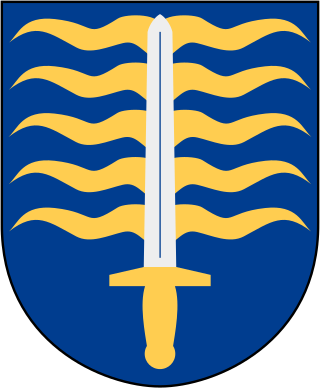See also
- Tyrfing Cycle, a collection of Norse legends
Tyrfing was a magic sword in Norse mythology.
Tyrfing or Tirfing may refer to:
Norse is a demonym for Norsemen, a Medieval North Germanic ethnolinguistic group ancestral to modern Scandinavians, defined as speakers of Old Norse from about the 9th to the 13th centuries.

Tyrfing, also rendered as Tirfing or Tyrving, was a magic sword in Norse mythology, which features in the Tyrfing Cycle, which includes a poem from the Poetic Edda called Hervararkviða, and the Hervarar saga. The name is also used in the saga to denote the Goths.
In Norse mythology, Dvalinn is a dwarf (Hjort) who appears in several Old Norse tales and kennings. The name translates as "the dormant one" or "the one slumbering". Dvalinn is listed as one of the four stags of Yggdrasill in both Grímnismál from the Poetic Edda and Gylfaginning from the Prose Edda.

In Norse mythology, Gylfi, Gylfe, Gylvi, or Gylve was the earliest recorded king of Sviþjoð, Sweden, in Scandinavia. He is known by the name Gangleri when appearing in disguise. The Danish tradition on Gylfi deal with how he was tricked by Gefjon and her sons from Jötunheim, who were able to shapeshift into tremendous oxen.

Hervarar saga ok Heiðreks is a legendary saga from the 13th century combining matter from several older sagas in Germanic heroic legend. It tells of wars between the Goths and the Huns during the 4th century. The final part of the saga, which was likely composed separately from and later than the rest, is a source for Swedish medieval history.
Fornjót is a jötunn in Norse mythology, and the father of Hlér ('sea'), Logi ('fire') and Kári ('wind'). It is also the name of a legendary king of "Finland and Kvenland". The principal study of this figure is by Margaret Clunies Ross.

Hjalmar and Ingeborg were a legendary Swedish duo. The male protagonist Hjalmar and his duel for Ingeborg figures in the Hervarar saga and in Orvar-Odd's saga, as well as in Gesta Danorum, Lay of Hyndla and a number of Faroese ballads. Hjalmar never lost a battle until meeting a berserker wielding the cursed sword Tyrfing.

Hervör is the name shared by two female characters in the Tyrfing Cycle, presented in The Saga of Hervör and Heidrek with parts found in the Poetic Edda. The first, the Viking Hervör, challenged her father Angantýr's ghost in his gravemound for his cursed sword Tyrfing. She had a son, Heidrek, father of the other Hervör. The second Hervör was a commander killed in battle with her brother.

Svafrlami was in the H and U version of the Hervarar saga the son of Sigrlami, who was the son of Odin. In the R version, Svafrlami is called Sigrlami and his parentage is not given. Svafrlami was the king of Gardariki and the first owner of the magic sword Tyrfing.

Arngrim was a berserker, who features in Hervarar saga, Gesta Danorum, Lay of Hyndla, a number of Faroese ballads and Orvar-Odd's saga in Norse mythology.
Angantyr was the name of three male characters from the same line in Norse mythology, and who appear in Hervarar saga, Gesta Danorum, and Faroese ballads.
Árheimar was a capital of the Goths, according to the Hervarar saga. The saga states that it was located at Danparstaðir, which is identified with the ruins of Kamjans'ke Horodyšče, near Kamianka-Dniprovska in southern Ukraine.
Ásmundar saga kappabana is the saga of Asmund the Champion-Killer, a legendary saga from Iceland, first attested in the manuscript Stockholm, Royal Library, Holm. 7, 4to, from the first half of the fourteenth century. It is essentially an adaptation of the German Hildebrandslied, but it has assimilated matter from the Tyrfing Cycle.
In Norse mythology, Durinn is a dwarf according to stanza 10 of the poem Völuspá from the Poetic Edda, and repeated in Gylfaginning from the Prose Edda. He was the second created after the first and foremost dwarf Mótsognir.
The Völsung Cycle is a series of legends in Norse mythology first extensively recorded in medieval Iceland, but which were also known in Sweden, Norway, England and (perhaps) the Isle of Man. The original Icelandic tales were greatly expanded with native Scandinavian folklore, including that of Helgi Hundingsbane, which, in turn, originally appears to have been a separate tradition connected to the Ylfings.
Several ships of the Swedish Navy have been named HSwMS Tirfing, named after Tyrfing, a magic sword in Norse mythology:

The naming of weapons in Middle-earth is the giving of names to swords and other powerful weapons in J. R. R. Tolkien's legendarium. He derived the naming of weapons from his knowledge of Medieval times; the practice is found in Norse mythology and in the Old English poem Beowulf. Among the many weapons named by Tolkien are Orcrist and Glamdring in The Hobbit, and Narsil / Andúril in The Lord of the Rings. Such weapons carry powerful symbolism, embodying the identity and ancestry of their owners.
Super Sonic Strike Missile (3SM) Tyrfing is a supersonic anti-ship missile under development by the Norwegian firm Kongsberg Defense & Aerospace (KDA).